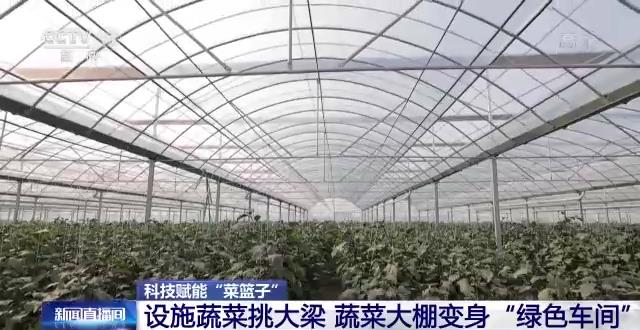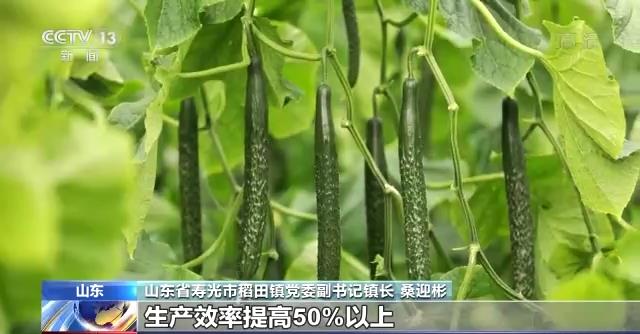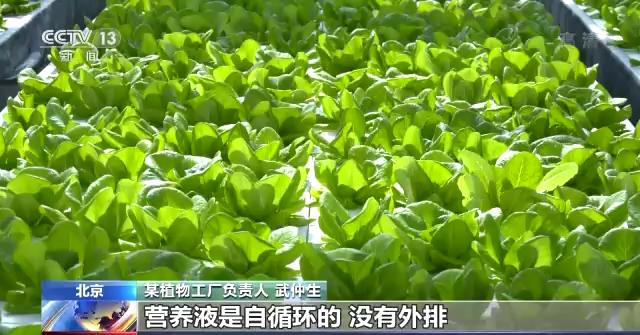Technology empowers the "vegetable basket"! See how the vegetable greenhouse turns into a "green workshop"
According to the latest data from the Ministry of Agriculture and Rural Affairs, the current vegetable field area in China is 94.35 million mu, an increase of 1.84 million mu year-on-year; In the first ten days of October, the output was 24.09 million tons, an increase of 710,000 tons. The national "vegetable basket" has stable production, sufficient supply and stable market.
"transporting western fruits to the east and southern vegetables to the north" enriches people’s dining tables
This is the largest vegetable market in East China — — Nanjing Agricultural and Sideline Products Logistics Center, with 30,000 trucks entering and leaving every day and 50,000 passengers every day, trades over 100,000 kinds of products every day, and the annual trading volume exceeds 11 million tons. Walking into the trading area with an area of tens of thousands of square meters here, it feels like entering a world of vegetables, with all kinds of fresh and exotic vegetables.
In the guest area of the market, more than 200 kinds of plateau dishes and inland dishes are gathered. These vegetables from other places are all transported over long distances.
Zhang Yuli, Market Manager of Nanjing Agricultural and Sideline Products Logistics CenterWe put the goods in the cold storage after they are delivered from farmers, and there is a cold chain in the process of transportation.
Sun Qinlong, Director of Guest Cuisine Department 2 of Zhongcai Vegetable Market, Nanjing Agricultural and Sideline Products Logistics CenterAll the way down at high speed, it will take nearly 2 hours to load, unload and set it up, and immediately go to the table of our people.
At the time of the interview, there were plateau dishes that were transported from other places and kept entering the market. As an important node of "transporting western fruits to the east and southern vegetables to the north", the cargo throughput of Nanjing agricultural and sideline products logistics center can reach about 30 thousand tons a day, and like these market merchants, they handle several thousand kilograms of vegetables every day.
Facility vegetables take the lead in vegetable greenhouses and become "green workshops"
There are more and more varieties of vegetables in the market, which are not only closely related to convenient logistics and transportation, but also closely related to the development of protected agriculture in China, especially protected vegetables. According to the data of the Ministry of Agriculture and Rural Affairs, at present, the output of protected vegetables in China accounts for 30% of the total main material, which has become an indispensable part of vegetable production and supply.
Protected vegetables refer to vegetables that are grown by artificial technical means to change the natural temperature conditions. Common facilities include greenhouses and greenhouses. According to the data of the Ministry of Agriculture and Rural Affairs, nearly 30 kinds of vegetables, including cucumbers, tomatoes and eggplants, have basically achieved annual production by manual methods.

Shouguang, Shandong, one of the important vegetable planting bases in China, has a vegetable planting area of 600,000 mu, and the proportion of protected vegetables has reached 95%. In the vegetable greenhouse of Cui Xinzhong, a villager in Daotian Town, Shouguang City, nearly 10 kinds of smart equipment including intelligent ventilator and intelligent plant protection machine were installed.
Cui Xinzhong, a villager from Cuilingxi Village, Daotian Town, Shouguang City, Shandong ProvinceLike my greenhouse, I can control it with a mobile phone. I turn on the fill light, and there is a newly installed intelligent cruise plant protection machine.

Now, Shouguang has completed and put into use 18 intelligent parks covering an area of 23,000 mu, all of which cover new technologies such as large-scale water and fertilizer integrated machine, intelligent temperature control and automatic light supplement. At the same time, more than 50,000 greenhouses have applied Internet of Things equipment, and vegetable greenhouses have become "green workshops".

Sang Yingbin, Deputy Secretary of the Party Committee of Daotian Town, Shouguang City, Shandong ProvinceCompared with the traditional solar greenhouse, the integrated application of advanced facility agricultural equipment can improve the land utilization rate by more than 30% and the production efficiency by more than 50%.
In addition to Shouguang, Shandong, at present, China has gradually formed five major facilities vegetable producing areas: Huanghuaihai, Bohai Rim, the middle and lower reaches of the Yangtze River, Northwest China, Northeast China and South China.
In Lingwu, Ningxia, the total planting area of local vegetables reached 61,800 mu, including 38,400 mu of protected vegetables. Due to the large temperature difference between day and night and sufficient sunlight, it provided unique conditions for the growth of cold vegetables.
Ma Ping, a villager in Xingwang Village, Lingwu County, is picking ripe tomatoes in her greenhouse. Tomatoes grown in the sand are juicy and juicy, which are deeply loved by consumers.
"Plant Factory": Let the vegetables reach the best growth state.
With the continuous development of modern facility agriculture, an efficient planting method "plant factory" has come, which does not need soil and sunlight. Follow the reporter to see the magical plant factory.
Before entering this plant factory in Beijing, the staff have to put on clean work clothes and go through the air shower room for disinfection. These processes are all to ensure that vegetables are protected from pests and diseases and can grow in a clean environment.
Wu Zhongsheng, head of a plant factoryFor example, including its illumination, humidity, temperature, carbon dioxide concentration, irrigation time, etc., these parameters are all controlled by computers, which are all tailored to plants and create the most suitable growth environment for plants.
Here, the roots of vegetables are not soil, but only water. There are not only various nutrients specially prepared in the water, but also good dissolved oxygen, and the water temperature can be adjusted according to the growth of plants, which not only provides the best growth conditions for vegetables, but also saves the water consumption needed for their growth.

Wu Zhongsheng, head of a plant factoryWe need about 500 ml of nutrient solution to produce a vegetable. The nutrient solution is self-circulating and has no external discharge.
In Henan, a 50-acre carbon-rich vegetable factory, nearly 17,000 tomatoes will ripen every seven days. Unlike ordinary field tomatoes, these tomatoes do not need any soil to grow, and the carbon dioxide emitted by thermal power plants is its "three meals a day".
Wang Xiaoqing, Head of Carbon-rich Vegetable Factory in Huixian County, Henan ProvinceOur vegetable factory is located next to the power plant, and the carbon dioxide generated by the power plant is delivered to our tomatoes, so that tomatoes can not only eat light and heat, but also eat gas fertilizer (carbon dioxide).
In this fully automatic plant factory in Pinghu, Zhejiang Province, LED lights are equipped here to simulate various spectra needed by plants, and specific spectra are turned on for special crops, so that vegetables can achieve an optimal growth state to ensure yield and quality.
Xue Longjiang, Deputy Director of Development Department of State Grid Pinghu Power Supply CompanyMicro-grid contains a micro-interactive system of hydrogen energy, and at the same time, it is equipped with some distributed photovoltaics, which can not only generate electricity continuously, but also provide usable heat energy.
The magic of the plant factory is that it presses the "fast forward button" for crop growth. Because the environment is closed and controllable, it is less affected by the natural environment and can be planted continuously in one year. Such a football field can produce 300 tons of vegetables every year, which is dozens of times more than the output of traditional vegetable fields in the same area.
Developing Facility Agriculture and Promoting Diversified Food Supply
Agriculture is the "ballast stone" to stabilize the economy and society. Developing facility agriculture is one of the important ways to build a strong agricultural country and achieve high-quality agricultural development. Establishing a big food concept and developing facility agriculture according to local conditions can promote the change of food supply from single production to multiple supply, and better meet the escalating consumer demand of agricultural products.